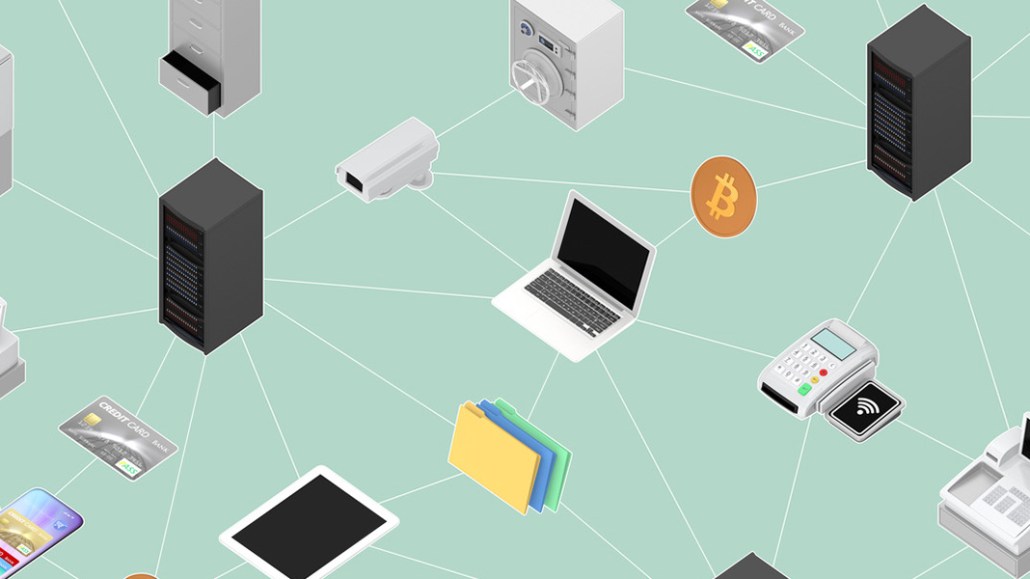
Advertisers’ love affair with all things blockchain may be cooling as they realize the technology’s potential to bring integrity back to ad buying will take time.
It’s been a year since the blockchain hype train reached advertising. The highs and lows of bitcoin’s price fluctuations in 2017 convinced many advertisers that blockchain powering it was some sort of cure-all solution to the lack of clarity around how media is bought and placed. Since then, however, the hype has faded.
Not only are advertisers split on when blockchain will be widely adopted by the industry, they’re also unsure if a technology that logs transactions between buyers and sellers in a way that doesn’t need third-party authentication will ease their concerns over undisclosed fees, ad tech taxes, fraud and opaque trading agreements. Blockchain falls somewhere between a game changer and a gimmick in the eyes of some ad industry observers now.
“The application of blockchain in advertising is still very nascent, and so while it’s being explored, we’ve only had a handful of inquires about it [from advertisers],” said Eamonn Maguire, KPMG’s global lead of blockchain. “I think it will be two to three years before blockchain becomes a dominant force in advertising as right now adoption is more like a smoke signal than a burning flare.”
While blockchain is on the radar for Lego’s marketers, there’s no firm plan for it yet, said the advertiser’s head of emerging platforms James Poulter.
“There are a few brands experimenting with blockchain on programmatic buys, but I think questions need to be asked of media agencies and whether they can come together on a shared platform that sits on something like Ethereum, for example,” said Poulter. “The problem is that everyone has to trust the system that they’re going to use and that will only happen if the industry can consolidate around some standards in terms of what [blockchain] solutions they will actually back.”
Before it even gets to that point, there are several longstanding barriers the technology has yet to hurdle.
Blockchain evangelists boast about the technology’s ability to process thousands of transactions per second. Ad exchanges process millions of transactions per second. That scale is too much to handle for most variations of the technology. Blockchain is also a drain on resources. As blockchains stretch to include more members and process more transactions, the cost of managing those expands too, particularly for the startups meant to be innovating the technology. It’s turned some advertisers skeptical of blockchain due to promises from solution providers over the last 18 months that have not come true.
“We’re looking at blockchain but more in terms of how it helps us as a distributor than an advertiser,” said Pernod Ricard’s global digital acceleration director, Pierre-Yves Calloc’h. “We are participating in discussions with the World Federation of Advertisers about the technology, but we’re not leading them. Blockchain is not the fastest technology today when it comes to the speed at which ads are traded, so we need to see it working in a real-world scenario first. The potential, however, for blockchain to be used on programmatic buys is undoubtedly there.”
Calloc’h is alluding to the costs-versus-value debate advertisers must consider before pouring money into the emerging technology. Blockchain’s upside is clearer for advertisers like Procter & Gamble, Unilever and Nestle that spend so much on media that they will make the initial outlay on the technology in the savings on media costs.
“The application of blockchain in programmatic is still in its infancy, and factors such as legacy contracts, preferred buying processes, and relationships mean that for many, realizing the benefits of blockchain might be slower than they like,” said Sam Fenton-Elstone, CEO of media agency Anything is Possible. “With blockchain technology in place across the ecosystem, publishers, agencies and brands will have access to centralized, scalable and efficient tracking, which puts budget holders in control again.”
There’s a growing sense among advertisers that there are few blockchain firms in the market with a genuine product. The Interactive Advertising Bureau’s Tech Lab announced a program last month to tackle the question by allowing its members to test technologies from blockchain startups such as MetaX, FusionSeven and Lucidity.
Despite reservations over the practicalities of the technology, some advertisers like GameStop think they’ve found a way to make it work.
Over the next 18 months, the retailer plans to work with blockchain advertising startup Lucidity and its ad tech partners AppNexus and Integral Ad Science to use the technology for all aspects of its programmatic buys including fraud detection and verification.
GameStop’s advertising agency The Richards group tested the technology with its ad tech partners in June when it was able to buy fewer fraudulent impressions for a campaign via the blockchain. Having that insight also meant the retailer could block specific sites trying to peddle fraudulent impressions.
Moving forward, GameStop plans to use the platform to audit its auditors IAS by making sure the way it views click-fraud matches the way both the demand-side platforms and supply-side platforms on its media plans do. Essentially, the retailer wants to manage a private marketplace of trusted partners to trade within the blockchain.
More in Media

Media Briefing: ‘Cloudflare is locking the door’: Publishers celebrate victory against AI bot crawlers
After years of miserably watching their content get ransacked for free by millions of unidentified AI bot crawlers, publishers were finally thrown a viable lifeline.

Vogue faces new headwinds as Anna Wintour — who agency execs say made ad dollars flow — shifts focus
Anna Wintour’s successor at Vogue will have to overcome the myriad of challenges facing fashion media and the digital publishing ecosystem.

Here are the biggest misconceptions about AI content scraping
An increase in bots scraping content from publishers’ sites represents a huge threat to their businesses. But scraping for AI training and scraping for real-time outputs present different challenges and opportunities.





